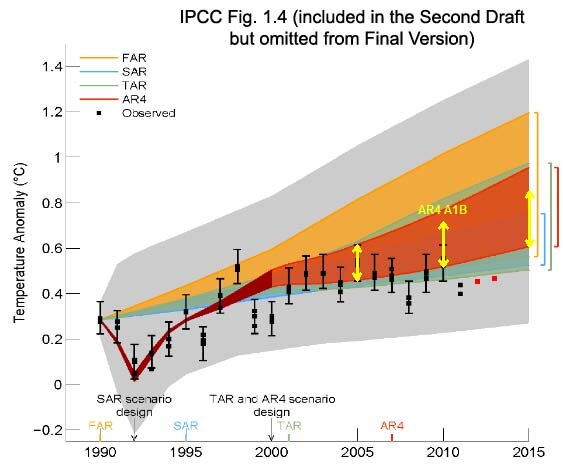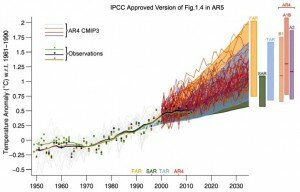(PRINCIPIA-SCIENTIFIC) – The UN’s Intergovernmental Panel on Climate Change (IPCC) published it’s Fifth Assessment Report (AR5) this week and already it is in crisis with accusations of malfeasance and pleas from climatologists for immunity from prosecution.
by John O’Sullivan
A critical backlash against AR5’s “junk science” is now in full swing and policymakers in Britain and Australia are already in full retreat from the travesty. The ongoing collapse in the UN’s climate cabal’s credibility puts a fresh light on why climatogists got in early with their formal request for immunity from prosecution at the Rio de Janeiro UN climate summit of 2012.
Today, prominent statistician Steve McIntye, one of the analysts often credited with exposing past IPCC ‘errors’ points to why this fiasco may rise to the level of criminality. McIntyre shows how UN officials systematically hid adverse data contained in the final draft review but omitted from the subsequent report now issued to the public. The world hasn’t seen this kind of orchestrated institutionalized deceit since the world banking crisis of 2008.
The astonishing plea by the world’s climatologists for immunity from prosecution was first reported last year when it surfaced embarrassingly during the Rio summit. At the time John Bolton, a former U.S. Ambassador to the UN, was quick to question the motives, “The creeping expansion of claims for privileges and immunities protection for UN activities is symptomatic of a larger problem.”
This week, in ‘IPCC: Fixing the Facts’ McIntyre identifies the evidence that proves how UN authors cynically removed from their final report facts that contradicted the propaganda set out in the Summary for Policymakers (SPM) issued only last Friday. Such stark evidence reveals that climatologists failed to predict the flatlining of temperatures in recent decades.
McIntyre observes:
“Figure 1.4 of the Second Order Draft clearly showed the discrepancy between models and observations, though IPCC’s covering text reported otherwise. I discussed this in a post leading up to the IPCC Report, citing Ross McKitrick’s article in National Post and Reiner Grundmann’s post at Klimazweiberl. Needless to say, this diagram did not survive. Instead, IPCC replaced the damning (but accurate) diagram with a new diagram in which the inconsistency has been disappeared.”
Here is Figure 1.4 of the Second Order Draft, showing post-AR4 observations outside the envelope of projections from the earlier IPCC assessment reports (see previous discussion here).
Figure 1. Second Order Draft Figure 1.4 (above). “Yellow arrows show digitization of cited Figure 10.26 of AR4.
Now here is the replacement graphic in the Approved Draft: this time, observed values are no longer outside the projection envelopes from the earlier reports. IPCC described it as follows:
Even though the projections from the models were never intended to be predictions over such a short time scale, the observations through 2012 generally fall within the projections made in all past assessments.”
McIntyre notes, “None of this portion of the IPCC assessment is drawn from peer-reviewed material. Nor is it consistent with the documents sent to external reviewers.“
The reason this ‘science’ appears so adulterated is adroitly explained by independent analyst, Dr. Richard North:
“Even now, the first part of the report, not published until yesterday, is a provisional draft. Crucially, we are told that it has to be read “in conjunction with the document entitled Climate Change 2013: The Physical Science Basis. Working Group I Contribution to the IPCC 5th Assessment Report – Changes to the Underlying Scientific/Technical Assessment“. This, we are instructed, is “to ensure consistency with the approved Summary for Policymakers (IPCC-XXVI/Doc.4) and presented to the Panel at its Thirty-Sixth Session”.”
This document”, we are further advised, “lists the changes necessary to ensure consistency between the full Report and the Summary for Policymakers, which was approved line-by-line by Working Group I and accepted by the Panel at the above-mentioned Sessions”. In other words, the summary, claimed to be based on the report, is published first, and then the report (or the first part of it) is published after the weekend, amended to match the summary which is supposedly based on it. With this legerdemain, one could be excused for dissolving into paroxysms of mirth.
These people cannot possibly be taken seriously. In fact, it is no laughing matter. Ross McKitrick was in 2012 a reviewer for the First and Second Order Drafts of the report. The expert review process is now closed, he notes, even though the report is still undergoing several rewrites.None of the changes introduced at this point will be seen by expert reviewers.
Government reviewers will have access to the text at one point, but very few of them bother to submit comments, and the IPCC rules permit Lead Authors to ignore them anyway. In past assessments this post-review rewrite has been the point at which some of the worst mischief has been done to the text.”












